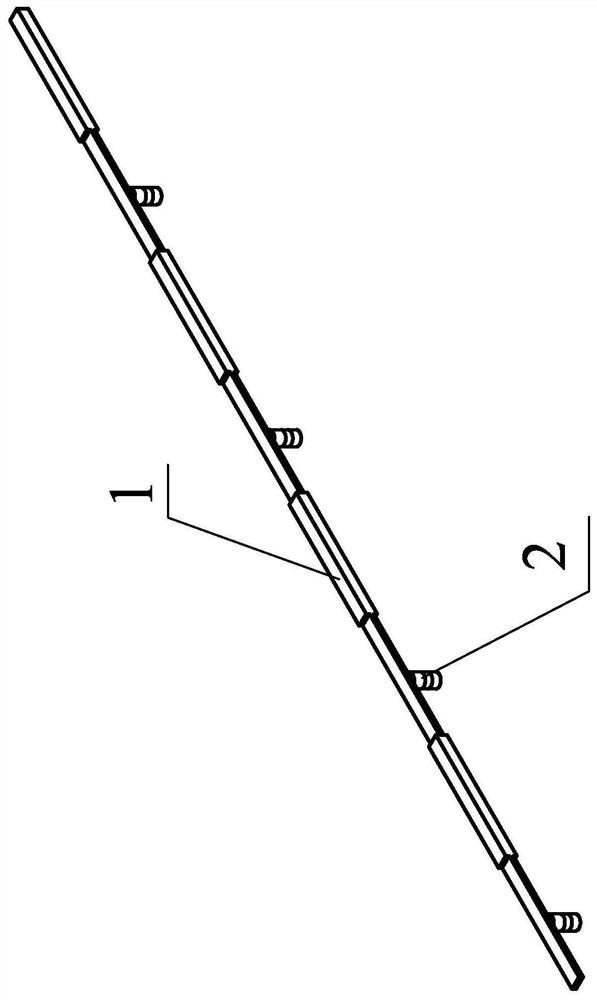A Variable-Section Acoustic Metamaterial Beam with Two Degrees of Freedom Local Resonance Elements
A technology of acoustic metamaterials and local resonance, which is applied in the direction of joists, girders, trusses, etc., can solve the problems of narrow local resonance bandgap bandwidth and small effective frequency range, and achieve firm and reliable bonding, low cost, Break through the effect of narrow bandwidth
- Summary
- Abstract
- Description
- Claims
- Application Information
AI Technical Summary
Problems solved by technology
Method used
Image
Examples
specific Embodiment approach 1
[0030] Specific implementation mode one: combine Figure 1 to Figure 4 To illustrate this embodiment, the variable-section acoustic metamaterial beam with a dual-degree-of-freedom local resonance unit includes M stepped beam assemblies, where M is a positive integer, and the M stepped beam assemblies are arranged in sequence along the long direction of the length. A fixed connection between two adjacent stepped beam components.
[0031] In this embodiment, when the length of the stepped beam assembly, the ratio of cross-sectional dimensions, and the length ratio of the thin beam section to the thick beam section are fixed, the rubber columns and mass blocks with various structural parameters in the stepped beam assembly can be designed to be bonded into different The local resonance unit, adjust the natural frequency of the local resonance unit, and then change the position of the local resonance bandgap, and realize the widening of the local resonance bandgap through the inte...
specific Embodiment approach 2
[0032] Specific implementation mode two: combination Figure 5 and Figure 8 Describe this embodiment. This embodiment is to further limit the stepped beam assembly in Embodiment 1. In this embodiment, the stepped beam assembly includes a stepped beam main body 1 and a two-degree-of-freedom local resonance unit 2. Each two-degree-of-freedom local resonance unit 2 is fixedly connected to a stepped beam main body 1, and the stepped beam main bodies 1 in two adjacent stepped beam assemblies are fixedly connected. Other compositions and connection methods are the same as those in Embodiment 1.
[0033] In this embodiment, the fixed connection mode of the ladder beam main body 1 in two adjacent ladder beam assemblies is bonding, which is convenient for increasing or decreasing the number of ladder beam assemblies according to experiments or practical applications, and at the same time, it is bonded to ensure firmness. At the same time, the material properties of the stepped beam ...
specific Embodiment approach 3
[0034] Specific implementation mode three: combination Figure 5 Describe this embodiment. This embodiment is to further limit the stepped beam main body 1 described in the second specific embodiment. In this embodiment, the stepped beam main body 1 includes a thin beam section 11 and a thick beam section 12. Both the beam section 11 and the thick beam section 12 are cuboids, one end of the thin beam section 11 and one end of the thick beam section 12 are integrally arranged, and the other of the thick beam section 12 in the previous stepped beam main body 1 of the two adjacent stepped beam main bodies 1 One end is fixedly connected with the other end of the thin beam section 11 in the latter ladder beam main body 1 . Other compositions and connection methods are the same as those in Embodiment 1.
PUM
 Login to View More
Login to View More Abstract
Description
Claims
Application Information
 Login to View More
Login to View More - R&D
- Intellectual Property
- Life Sciences
- Materials
- Tech Scout
- Unparalleled Data Quality
- Higher Quality Content
- 60% Fewer Hallucinations
Browse by: Latest US Patents, China's latest patents, Technical Efficacy Thesaurus, Application Domain, Technology Topic, Popular Technical Reports.
© 2025 PatSnap. All rights reserved.Legal|Privacy policy|Modern Slavery Act Transparency Statement|Sitemap|About US| Contact US: help@patsnap.com



